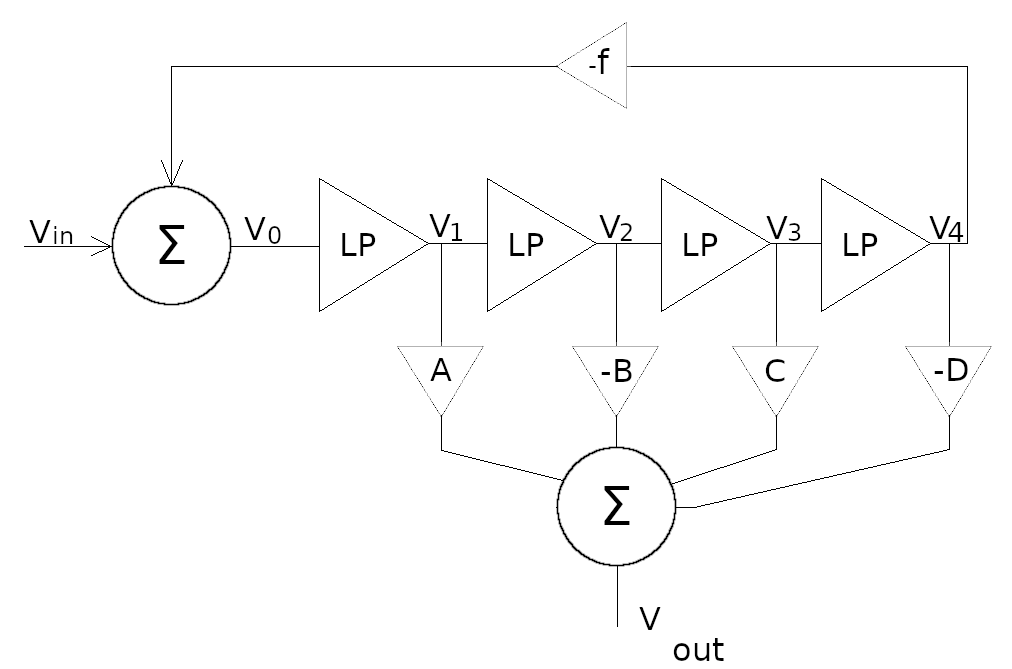Let's look at the Xpander filter a little more closely. The structure is similar to the generic 4 pole filter. If you haven't gone through that, it should be considered a requisite. If you set the A term from the base 4 pole filter to 0, the two are structurally equivalent, although here we're using A as the amplification factor starting on V1. Additionally, in the Xpander 3 pole modes the first filter pole has its pole moved upwards by a factor of 330. We've included that pole in the calculations.

-
Solving for V0 to V4
ThereforeV0 = Vin - fV4 V1 = V0 (.0030303s+1) Here, we're adding a factor to account for the way the Xpander switches out it's first low pass stage, by simply moving the pole to a very high frequency. The ratio of the capacitor values is 33nF:.1nF or 330:1. V2 = V1 (s+1) = V0 (.0030303s + 1)(s+1) V3 = V2 (s+1) = V0 (.0030303s + 1)(s+1)^2 V4 = V3 (s+1) = V0 (.0030303s + 1)(s+1)^3
V4 = Vin - fV4 (.0030303s + 1)(s+1)^3 Let's define Den3 = (.0030303s + 1)(s+1)^3 V4 = Vin - fV4 Den3 V4Den3 = Vin - fV4 V4Den3 + fV4 = Vin V4(Den3 + f) = Vin V4 Vin = 1 (Den3 + f) So we have the transfer function for V4. Now, it's helpful to divide the top and bottom by Den3. = 1 Den3 1 Den3 = 1 Den3 1 + f Den3 = 1 Den3 (1 + f Den3 This is a convenient form as it lets us rewrite the V4 transfer function in a form that looks like the standard 4 pole LP transfer function with an added F term. The original form with small f will be used later when expanding the common denominator 1 Den3 F
where F = 1 +f Den3
With the transfer function in this form, we can easily define V1, V2, and V3 by adding succesive (s+1) terms to the numerator and reducing. We don't have a need for V0:
V4 =1 Den3 F 1 (.0030303s + 1)(s+1)^3 F
V3 =(s+1) Den3 F 1 (.0030303s + 1)(s+1)^2 F
V2 =(s+1)^2 Den3 F 1 (.0030303s + 1)(s+1) F
V1 =(s+1)^3 Den3 F 1 (.0030303s + 1) F
Now we can sum the individual responses into our mixing network.
-
Mix equation for 4 poles with feedback
We can see that Vout is just AV1 - BV2 + CV3 - DV4
Substituting the transfer functions we found previously gives us:
Vout Vin A (.0030303s + 1) F B (.0030303s + 1)(s+1) F C (.0030303s + 1)(s+1)^2 F D (.0030303s + 1)(s+1)^3 F
the common denominator is (.0030303s + 1)(s+1)^3 F, so we can multiply each by the common denominator, cancel the common terms and expand the (s+1) exponential terms. Note that all of the F terms will cancel. -
Numerators
A(s+1)^3 => As^3 3As^2 3As + A -B(s+1)^2 => -Bs^2 - 2Bs - B C(s+1) => Cs + C D => - D + As^3 + (3A - B)s^2 + (3A - 2B + C)s A - B + C - D
As it turns out, this is the same numerator polynomial you get with or without feedback, due to the cancellations of the F terms. The F term will only appear in the denominator. We also don't end up with the shifted pole term (.0030303s + 1) in the numerator since we're not using V0. -
Combined numerator coefficients
replacing s with jw, we can group the real and imaginary parts
real terms: R = -(3A - B)w^2 + (A - B + C - D)
imaginary terms: I = j [ -Aw^3 + (3A - 2B + C)w ]
The magnitude of the numerator can then be found by Magn = √( R^2 + I^2 ) -
Denominator
The common denominator is Den3F. We showed before that
Den3 F = Den3 + f (note big F on left and small f on right)
real terms: R = .0030303w^4 - 3.0090909w^2 + 1 + fDen3 + f = (.0030303s + 1)(s+1)^3 + f = (.0030303s + 1)(s^3 + 3s^2 + 3s + 1) + f = (.0030303s^4 + 1.0090909s^3 + 3.0090909s^2 + 3.0030303s + 1 + f
imaginary terms: I = j [ -1.0090909w^3 + 3.0030303w ]
The magnitude of the denominator can likewise be found by Magd = √( R^2 + I^2 ) - The total magnitude is then just Magn / Magd
References and further reading
- Electric Druid has more discussion of the Xpander / Matrix 12 modes, as well as schematics of a modern take on pole mixing and links to even more reading.
